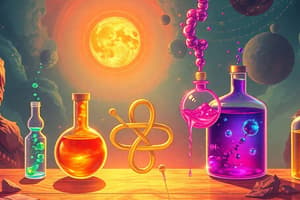Podcast
Questions and Answers
What does the rate of a chemical reaction refer to?
What does the rate of a chemical reaction refer to?
- The amount of products formed
- The concentration of reactants used
- The speed at which reactants are converted into products (correct)
- The temperature at which the reaction takes place
According to collision theory, when does a reaction occur?
According to collision theory, when does a reaction occur?
- When a catalyst is not present
- When the reactants have a low concentration
- When the reactant molecules collide with the appropriate orientation and energy (correct)
- When the temperature is very low
What do reaction mechanisms describe?
What do reaction mechanisms describe?
- The temperature at which the reaction occurs
- The overall reactants and products involved in a reaction
- The intermediates and pathways in a chemical reaction (correct)
- The rate of the reaction
How is the strength of an acid or base determined?
How is the strength of an acid or base determined?
What does Le Chatelier's principle help predict?
What does Le Chatelier's principle help predict?
Flashcards are hidden until you start studying
Study Notes
Chapter 1: Chemical Reactions in Class 12 Chemistry
Chemical reactions are the foundation of chemistry, forming the basis for understanding the transformations of matter that occur in the natural world. As you delve into Chemistry Class 12 Chapter 1, let's explore the fundamental concepts and mechanisms behind chemical reactions, setting the stage for your deeper studies.
Reaction Types
Chemical reactions can be classified into two major types: Synthesis (or combination) and Decomposition. In a synthesis reaction, two or more simple substances combine to form a more complex substance. Conversely, a decomposition reaction occurs when a single compound is broken down into simpler substances.
Balancing Equations
Balancing chemical equations is a crucial step in understanding the stoichiometry of chemical reactions. This process involves adjusting the coefficients in front of the chemical formulas to ensure that the number of atoms of each element is equal on both sides of the equation. Balanced equations not only provide an accurate representation of the reaction but also help in calculating the amount of reactants and products.
Stoichiometry
Stoichiometry, the quantitative aspect of chemistry, is essential in predicting the amounts of reactants and products in a chemical reaction. Knowledge of stoichiometry allows chemists to determine the limiting reactant, the efficiency of a reaction, and the amount of energy released or absorbed during a reaction.
Reaction Rates
The rate of a chemical reaction refers to the speed at which reactants are converted into products. Factors that influence reaction rates include concentration, temperature, and the presence of a catalyst. Collision theory, a widely accepted model to explain reaction rates, suggests that a reaction occurs only when reactant molecules collide with each other with the appropriate orientation and energy.
Reaction Mechanisms
Reaction mechanisms describe the step-by-step process that occurs during a chemical reaction, providing details about the intermediates and the pathways that lead to the formation of products. Understanding reaction mechanisms helps chemists predict reaction rates and product yields.
Acids and Bases
In Chemistry Class 12, you will also explore the concept of acids and bases. Acids are proton donors, and bases are proton acceptors. The strength of an acid or base is determined by its affinity for protons. The relationship between acids and bases is described by the Bronsted-Lowry theory, which identifies acids as proton donors and bases as proton acceptors.
Equilibrium
Finally, we will discuss the concept of equilibrium, a state in which the rate of a forward reaction is equal to the rate of the reverse reaction. The equilibrium constant, Kc, describes the relative proportions of reactants and products at equilibrium. Le Chatelier's principle helps us predict how shifting conditions will affect the position of an equilibrium.
In summary, Chemistry Class 12 Chapter 1 provides an in-depth examination of the fundamental concepts of chemical reactions. The topics discussed form the cornerstone of your studies, and a solid understanding of these concepts will help you tackle more advanced topics in chemistry.
Studying That Suits You
Use AI to generate personalized quizzes and flashcards to suit your learning preferences.




